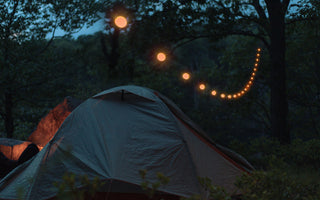So…. it’s just a giant skinny battery?”
Yes. Yes it is. And turns out, it takes a lot of engineering to make that happen.

Side view of installed Backup measuring 2.8" deep WITH the bracket
When we set out to make Backup we knew we wanted to accomplish 3 things:
- We wanted to make it way more affordable than a whole-home solution
- We wanted to enable a user to install it themselves
- We wanted it to be an in-room solution with automatic activation
When we went out and did early rounds of user research, two key insights were added to the mix:
- People are most concerned about the Fridge when the power goes out
- Current portable power solutions offer an alternative to whole home options, but they're heavy, bulky, and take up useful living space when they’re in-use (otherwise, they’re sitting in a closet or garage)
If we didn’t want to take up precious living space but earn a permanent spot in the room, we needed to look around and see what else might be available - enter the forgotten spaces.
Forgotten Spaces
Behind your fridge. Beneath a desk. Under a bed. As we started to examine priority rooms, we identified nooks and crannies that were underutilized because of their narrow dimensions, but also out of the way of the daily flow of life. These were perfect spaces to slip Backup into a room so it could be locally available, close to an outlet, but basically invisible.

We started to explore shapes and dimensions that mirrored common items at home: 12-packs, shoeboxes, flatscreens, pizza boxes. We landed on a “magic rectangle” design that would fit on top of most fridges in the US and fit within the depth of common lower cabinetry. Now we just had to shrink a 1.5 kWh battery down to the smallest profile the world had ever seen and make sure it didn’t generate high levels of exhaust heat - easy right?
Turns out, the challenge isn’t the energy storage cells - it’s the inverter.
Inverter 101
Inverters exist inside of energy storage systems to convert DC to AC power which is the type of power that most of our common corded household appliances use. Inverters tend to be big and bulky mainly for two inter-related reasons: one, large switching components are needed for the conversion process and lose some of the energy in the form of waste heat. Two, because of that waste heat, inverters typically contain large heat sinks with fans and side vents inside their design to help regulate temperatures and maintain safe operation. These are our bulky culprits.
The Skinny on Backup’s Advanced Inverter
Through material selection and mechanical engineering, we were able to make two significant leaps in our patented inverter design:
1) Using gallium nitride (GaN) transistors, we were able to use smaller transistor components AND increase the efficiency of the inverter from the standard of 85-88% all the way up to 95-97%. More efficiency = less waste heat and less pressure on the system for thermal regulation.
2) We relocated the heat sinks from the internals of the inverter to the external structure of Backup, making the entire back panel of Backup an active heatsink. We touched on this in our Safety Tour, but as a quick refresher here that not only provides a large surface area to dissipate the minimal waste heat, it also adds structural integrity to the overall unit.

Relatedly, for folks who see the fully enclosed design and think wait, doesn’t that get hot? Where does the airflow go? The answer is, the enclosed design actually works in everyone’s favor! We’re used to seeing big vents and loud fans on energy systems because of the waste heat that they generate, so we associate that as a required design. Not true. Because of our high-efficiency and heat sink enclosure, we are able to successfully regulate temperatures without requiring outside air to blow into the system which briiiiings us back to our original charge of designing for forgotten spaces.
Guess what gets dusty? Forgotten spaces.
Guess what doesn’t do well with dust blowing over it? Sensitive internal electronics.
Guess who doesn’t need dusty air to blow on it to keep it cool? Backup by BioLite.
(Cue engineers doing a casual high-five.)
Bringing It All Home… Into Your Home.

Backup was made to fit into your existing life without disrupting it and that’s why form factor was so critical to delivering that promise. No cords to trip over, no giant boxes to skirt around, no counter space taken up. Clocking in at just 2.8” in depth, Backup is ready for your gaps and forgotten spaces and will keep cool while being there.
We did the hard stuff so the actual experience can be incredibly easy. If it looks slim and simple on the outside, we’ve done our job.



